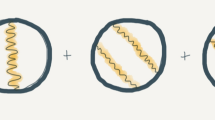Abstract
The symmetrization postulates of quantum mechanics (symmetry for bosons, antisymmetry for fermions) are usually taken to entail that quantum particles of the same kind (e.g., electrons) are all in exactly the same state and therefore indistinguishable in the strongest possible sense. These symmetrization postulates possess a general validity that survives the classical limit, and the conclusion seems therefore unavoidable that even classical particles of the same kind must all be in the same state—in clear conflict with what we know about classical particles. In this article we analyze the origin of this paradox. We shall argue that in the classical limit classical particles emerge, as new entities that do not correspond to the “particle indices” defined in quantum mechanics. Put differently, we show that the quantum mechanical symmetrization postulates do not pertain to particles, as we know them from classical physics, but rather to indices that have a merely formal significance. This conclusion raises the question of whether many discussions in the literature about the status of identical quantum particles have not been misguided.
Article PDF
Similar content being viewed by others
Avoid common mistakes on your manuscript.
References
Black, M.: The identity of indiscernibles. Mind 61, 153–164 (1952)
Dieks, D.: Quantum statistics, identical particles and correlations. Synthese 82, 127–155 (1990)
Dieks, D., Versteegh, M.A.M.: Identical particles and weak discernibility. Found. Phys. 38, 923–934 (2008)
Dieks, D.: Are ‘identical quantum particles’ weakly discernible objects. In: Suarez, M., Dorato, M., Redei, M. (eds.) EPSA Philosophical Issues in the Sciences: Launch of the European Philosophy of Science Association, vol. 2, pp. 21–31. Springer, Berlin (2010)
French, S., Krause, D.: Identity in Physics: A Historical, Philosophical, and Formal Analysis. Oxford University Press, London (2006)
Lubberdink, A.: De individualiseerbaarheid van identieke deeltjes. Master Thesis, Utrecht University (1998). http://gradthesis.andrealubberdink.nl
Lubberdink, A.: Identical particles in quantum mechanics. arXiv:0910.4642
Mullin, W.J., Blaylock, G.: Quantum statistics: is there an effective fermion repulsion or boson attraction? Am. J. Phys. 71, 1223–1231 (2003)
Muller, F.A., Saunders, S.: Discerning fermions. Br. J. Philos. Sci. 59, 499–548 (2008)
Muller, F.A., Seevinck, M.: Discerning elementary particles. Philos. Sci. 76, 179–200 (2009)
Quine, W.V.: Grades of discriminability. J. Philos. 73, 113–116 (1976). Reprinted in Quine, W.V.: Theories and Things. Harvard University Press (1981)
Saunders, S.: Physics and Leibniz’s principles. In: Brading, K., Castellani, E. (eds.) Symmetries in Physics: Philosophical Reflections, pp. 289–307. Cambridge University Press, Cambridge (2003)
Saunders, S.: Are quantum particles objects? Analysis 66, 52–63 (2006)
Teller, P.: Quantum mechanics and haecceities. In: Castellani, E. (ed.) Interpreting Bodies: Classical and Quantum Objects in Modern Physics, pp. 114–141. Princeton University Press, Princeton (1998)
van Fraassen, B.: Quantum Mechanics: An Empiricist View. Oxford University Press, London (1991)
von Neumann, J.: Mathematische Grundlagen der Quantenmechanik. Springer, Berlin (1932) and (1996)
Zurek, W.H.: Decoherence and the transition from quantum to classical—revisited. In: Duplantier, B., Raimond, J.-M., Rivasseau, M. (eds.) Quantum Decoherence, Poincaré Seminar 2005. Progress in Mathematical Physics, vol. 48, pp. 1–31. Birkhäuser, Basel (2007)
Author information
Authors and Affiliations
Corresponding author
Rights and permissions
Open Access This is an open access article distributed under the terms of the Creative Commons Attribution Noncommercial License (https://creativecommons.org/licenses/by-nc/2.0), which permits any noncommercial use, distribution, and reproduction in any medium, provided the original author(s) and source are credited.
About this article
Cite this article
Dieks, D., Lubberdink, A. How Classical Particles Emerge From the Quantum World. Found Phys 41, 1051–1064 (2011). https://doi.org/10.1007/s10701-010-9515-2
Received:
Accepted:
Published:
Issue Date:
DOI: https://doi.org/10.1007/s10701-010-9515-2



